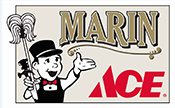Aka why we dislike Lavandula
Recently we have been asked a lot about what plants will do well outside versus inside. We were interested in this question, especially when our Garden Guru (yes, we have a Garden Guru, his name is Owen) told us that depending on the climate there is no difference! This blew our minds a little and so we decided to investigate and then to share with you, our readers. So buckle up for the ultimate fight:
Indoor Plant vs. Outdoor plant!!!!
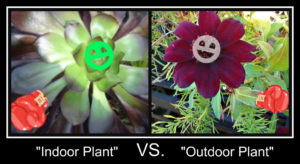 Okay, that picture is a little silly especially since all plants are outdoor plants. They all were originally discovered and then cultivated from some plant that someone found and thought was cool (Yes, unless it’s a hybrid but even then it’s parents were outdoor plants). Really, the argument is more about where we live and what grows here natively, versus what can grow here with cultivation, and what can’t grow here so it has to live in the house with us. So first things first:
Okay, that picture is a little silly especially since all plants are outdoor plants. They all were originally discovered and then cultivated from some plant that someone found and thought was cool (Yes, unless it’s a hybrid but even then it’s parents were outdoor plants). Really, the argument is more about where we live and what grows here natively, versus what can grow here with cultivation, and what can’t grow here so it has to live in the house with us. So first things first:
What is a Native plant and why does it matter?
Native plants are what they sound like if you had gotten here before there was contact with the outside world and walked around San Rafael you would have seen Oak trees, and tall reeds. There would be no green lawns as we know them. There would have been scrub on the hills and some pines, but not apple trees, or rose bushes. There would have been mint, but no lavender.
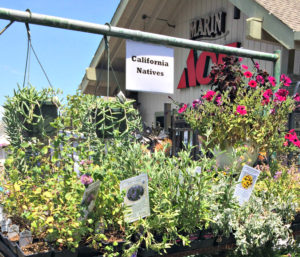
Simply put a native plant is a plant that has adapted to the particular climate and specific region that it is found growing in. How these plants spread here, and when is a matter for Paleobotonists, and not we mere blog-writing mortals. But what is important is that we know that plants native to our region will do just fine outside. The conditions that make them flourish will be easy to create as they have adapted to here.
What is a non-native plant?
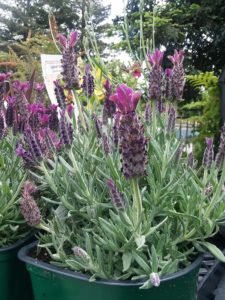
There are other types of plants that are not native but can be grown with cultivation. We mentioned lavender above as it seems to be a universal plant in this area. There is even a large lavender maze up in Santa Rosa. Lavender is a hardy plant that can grow in many climates, it is native however to the old world. It naturally grows from Europe to southeast India and down to mid-Africa. That is a lot of land and the widespread nature means that it has acclimatized to many different areas. It is easy to cultivate, and as long as you have a plant that is “hardened” to your area then it will also do fine if you just plop it outside. But here’s the thing, Lavender will also do well inside. It does well due to its versatility. It is an unfortunate truth that our numerous micro-climates produce less hardy plants and plants like lavender have no issue invading space that out more sensitive native plants would normally occupy, but now we are venturing into the world of the Ecobotonist and we really need to stay on track.
What Do People usually mean by “Indoor Plant”?
When people come in and ask for an indoor plant they usually think (as we did before Owen blew our minds) that they are looking for a:
-Spider Plant
-Fichus
-Tillandsia
-Succulent
-Orchid
-Bromeliads
-Rubber Plant
-Peace Lily
-String of Pearls (the hipster know what this is)
These plants, while some might be native to a certain extent (we do have some native succulents in the Bay Area) are for the most part tropical plants that require high humidity, low nutrient soil, and specific amounts of light/dark. In other words, these plants have adapted to live in some of the hardest places to live either due to too much/not enough water/resources and if they are jungle plants a lot of competition. So when we bring these super tough plants to our balmy Mediterranean Climate with our consistent temperatures thanks to the Giant HVAC unit known as the Pacific Ocean they tend to be high maintenance.
It is not really the plant’s fault, after all, we as humans are one of the best adapting species on earth and we whine when it gets just out of our comfort zone of 70 degrees to 75 degrees. So the plants which are adapted to a wildly different climate are reacting pretty much how we would if we were suddenly dropped in the artic without a coat or the desert, in a coat.
Can I grow “outdoor plants” inside?
As before stated, all plants are outdoor plants. But what we think most people mean is how, or can you grow something like a rose bush inside? The answer is you can. Like tropical plants, the key to growing a “normal” outdoor plant inside is understanding the environment that it naturally grows in. Some plants are going to need a compromise, you will need to make sure that they have full access to natural light. You will need to make sure to check soil conditions as the soil will not be renewing itself if it is in a pot and the plants will thus need to be fed.
However, almost all plants can be trained to be indoor plants. For proof take for instance the local cannabis trade. Cannabis is a plant native to Southeast Asia which has a wildly different climate from our own. However, by learning how to grow the plants hydroponically with sun lamps to simulate the Southeast Asian sun, a huge industry is booming by bringing these outdoor plants inside.
Cannabis may not be the best example however as it is, of course, a tropical plant, no matter how well it grows in the wilds of Humboldt county. But bonsai can be almost any tree and with careful cultivation can be grown in miniature in a pot. So, if you can grow a Spruce in a 10″ pot, then yes, you can bring your rosebush inside. But please not the Cannabis or lavender (we are allergic to both). (By the way, Bonsai is a really cool way to grow plants with a long storied history, read more about it here.)
Why can’t I plant my Venus Fly Trap in the garden?
We know that there are carnivorous plants native to California. There are whole meadows of Pitcher plants up in the Plumas National Forest not to mention sundews that trap insects with long sticky petal-like things (that’s the scientific name for them (it’s not, we lied and are too lazy to look it up)). So, why can’t you plant any old carnivorous plants in your garden? Well, it comes back to the whole native vs. non-native discussion. Carnivorous plants all develop in very specific conditions where there cannot be too many nutrients in the soil, thus why they have to eat insects. Simply put, your garden is in too good of condition for a carnivorous plant.
Even the California Pitcher Plant is native to the swampy areas of the mountains, with peat bogs, and freshwater that is not rejuvenated by tidal flow. It is true that in the bay area we have a lot of what might be seen as swampy land, but it isn’t. We are surrounded by saltwater marshes and estuary. The combination of the salt and the high level of nutrients brought by the constant tidal ebb and flow make our area unsuitable for a plant that will die if not in an area of low nutrition.
Carnivorous plants are very sensitive, and even when kept inside in perfect conditions can die. These are plants that evolved to always live right on that thin line of life and death, and when we stress them out, they sometimes just throw in the towel. (Not literally, we don’t think they own towels).
If you want a carnivorous plant, please make sure that you obtain one from a vendor that gets theirs from a local nursery where the plants would have been propagated locally. That will be your best chance of growing the carnivorous plant of your dreams (unless your dreams include du-wop and Rick Moranis because yes, most plants can actually live quite well on human blood, but that’s kinda weird(but we do sell bloodmeal though, because feeding plants with cows blood is less weird))
How do I know if something will do better inside or out?
This is down to a lot of factors, including what kind of care you are willing to give something, where you would be planting it? And where in our land of hundreds of micro-climates your house is. We highly recommend that to take the guesswork out of it you contact the local Master Gardeners here: or do what we do, just ask Owen!
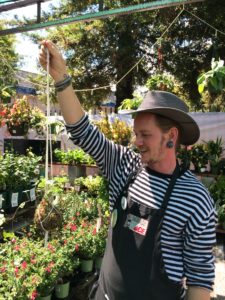
Owen is not only a garden guru but also a bit of a macrame savant.
